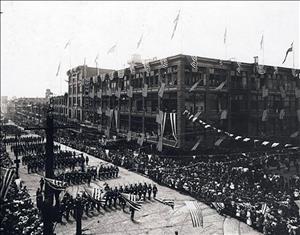On May 23, 1908, the Great White Fleet arrives in Seattle. The visit is part of a 14-month cruise around the world by the 16 battleships and 14,000 sailors of the U.S. Navy's Atlantic Fleet, a feat never attempted before. The cruise is a exhibition of U.S. fighting abilities, particularly to the Empire of Japan, which had recently defeated Russia in a sea battle.
After the Spanish American War (1898), President Theodore Roosevelt (1858-1919) sought to include the U.S. in world affairs. In 1905, during the Russo-Japanese War, Japanese naval units defeated the Russian Baltic Fleet at the battle of Tsushima. Roosevelt negotiated a peace between the combatants.
In 1907, Japan protested the segregation of Japanese students in San Francisco, which resulted in reversal of the school policy. So that the Japanese did not think that the U.S. feared Japanese military power, Roosevelt ordered the Atlantic Fleet on a trip around the world. The white-painted battleships earned the name Great White Fleet. Roosevelt once declared, "There is a homely adage which runs, 'Speak softly and carry a big stick; you will go far.' If the American nation will speak softly and yet build and keep at a pitch of the highest training a thoroughly efficient navy, the Monroe Doctrine will go far" (Bartlett's).
The fleet left Norfolk, Virginia, on December 16, 1907, and arrived in Puget Sound in May by way of South America and San Francisco. The ships visited Port Angeles and Bellingham before arriving in Seattle on May 23.
Seattle Mayor John F. Miller presented Rear Admiral C. S. Sperry with the key to the city (made from Klondike gold). Theater owners gave out 3,000 tickets to sailors and the Seattle Electric Co. supplied 50,000 streetcar tickets. Officers and men were feted all over the city. Newspapers were full of stories profiling the ships, the commanders, and Roosevelt's naval and foreign policies.
On May 26, 1908, the sailors, along with soldiers, militia, and fraternal orders paraded up 2nd Avenue to the cheers of 300,000 people.
The fleet left for Tacoma on May 27. From there, the ships steamed to the Far East via Australia and then on to the Mediterranean and home.

